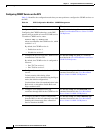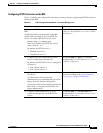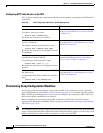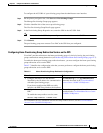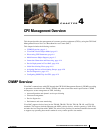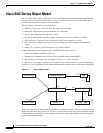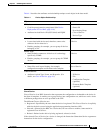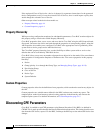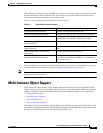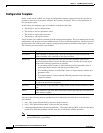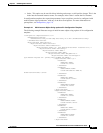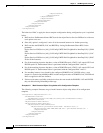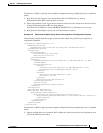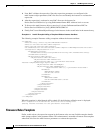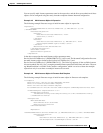
4-4
Cisco Broadband Access Center 3.8 Administrator Guide
OL-27172-01
Chapter 4 CPE Management Overview
Discovering CPE Parameters
If the registered Class of Service for a device is changed, it regenerates instructions for the generated
device configuration even if it is not the selected Class of Service, since it could impose a policy that
would change the selected Class of Service.
Other concepts related to the device data model are:
• Property Hierarchy, page 4-4
• Custom Properties, page 4-4
Property Hierarchy
While processing configuration templates for substitutable parameters, Cisco BAC searches objects for
this property using a certain order called Property Hierarchy.
Cisco BAC properties allow you to access and store data in Cisco BAC using the API. Preprovisioned,
discovered, and status data can be retrieved through the properties of corresponding objects, using the
API. Properties also enable you to configure Cisco BAC at the appropriate level of granularity (from
system level to device groups and to individual devices).
The Cisco BAC property hierarchy gives you the flexibility to define system-wide or service class
defaults that can be overridden by individual devices.
Cisco BAC allows you to store any number of properties on objects in its data model. You can reference
these properties in configuration templates or firmware rules. You can use properties in this property
hierarchy:
1. Device
2. Group (priority is set through the Group Type, see Managing Group Types, page 16-18)
3. Provisioning Group
4. Class of Service
5. Device Type
6. System Defaults
Custom Properties
Custom properties allow for the definition of new properties, which can then be stored on any object via
the API.
Custom properties are variable names defined in the RDU, and must not contain any spaces. The
template parser works from bottom up when locating properties in the hierarchy and converts the
template option syntax. For detailed information, see Custom Properties, page 5-15.
Discovering CPE Parameters
Cisco BAC is enabled to read CPE parameters using Remote Procedure Calls (RPCs) as defined in
CWMP. This is made possible through the Data Synchronization Instruction. This instruction discovers
data from the CPE device, reports it to the RDU, and keeps the RDU up-to-date when CPE device data
changes.



